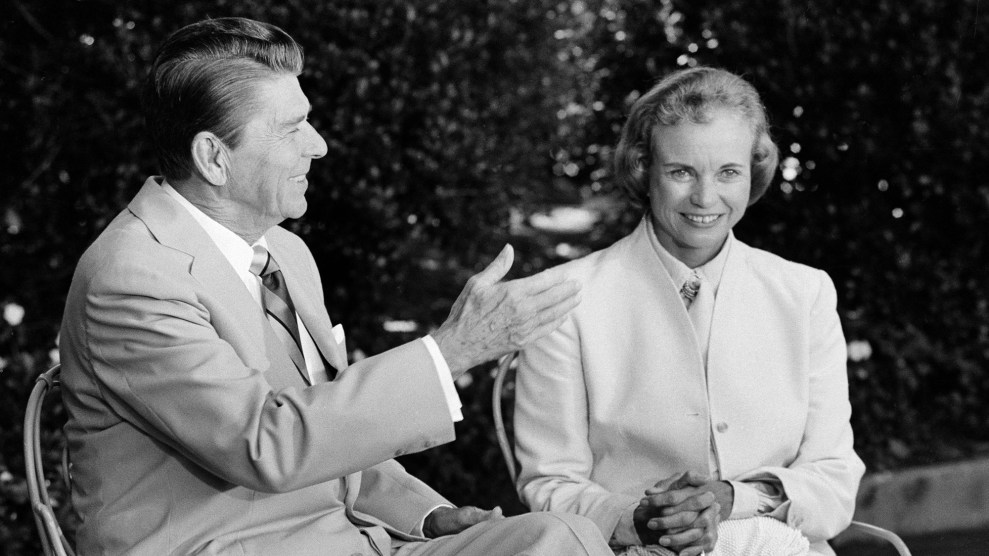
President Reagan presents his Supreme Court nominee Sandra Day O'Connor to members of the press in the White House Rose Garden, July 15, 1981. File/AP
Sandra Day O’Connor, the first woman to serve on the US Supreme Court, has died at the age of 93. O’Connor slipped away from public life in 2018 when she announced that she had been diagnosed with early dementia. This is the same disease that had prompted her to retire from the court in 2006 to care for her husband, John Jay O’Connor III, who died from Alzheimer’s in 2009.
“A daughter of the American Southwest, Sandra Day O’Connor blazed a historic trail as our Nation’s first female Justice,” Chief Justice John G. Roberts, Jr. said in a statement. “She met that challenge with undaunted determination, indisputable ability, and engaging candor. We at the Supreme Court mourn the loss of a beloved colleague, a fiercely independent defender of the rule of law, and an eloquent advocate for civics education. And we celebrate her enduring legacy as a true public servant and patriot.”
Appointed by Ronald Reagan in 1981, O’Connor was not unusual just for being a woman. Born in El Paso, Texas, and raised in Arizona, she also was the rare Westerner to join the court—she could milk a cow and ride a horse—and she was the last justice who didn’t come straight from a federal appellate court. In fact, O’Connor’s legal background was far broader in many ways than the justices who came after her. Before becoming a state court judge in Arizona, she served in the Arizona state legislature, eventually becoming the state senate majority leader in 1972. She understood politics in ways most of her brethren did not and had long practiced bipartisanship to get things done.
For her, gender discrimination was quite personal. She graduated top of her class at Stanford Law in 1952, only to discover no firm would hire her as anything but a secretary. So she struck out on her own, finding a career in public service. (I like to think that her Western common sense was also behind her sensible decision to turn down a marriage proposal in the early 1950s from her Stanford classmate, the late Chief Justice William Rehnquist, who later would be credibly accused of harassing minority voters at the polls in the 1960s.)
Her real-world sensibilities informed her Supreme Court jurisprudence, which often drove conservatives mad because it made her both less predictable and more moderate than they would have preferred—especially in the area of reproductive rights. She consistently voted to uphold these rights and co-wrote the majority opinion in the 1992 case, Planned Parenthood v Casey, which helped to preserve Roe v Wade until it was finally undone by her replacement on the bench, Justice Samuel Alito. He wrote the majority opinion in last year’s Dobbs decision that completely eradicated the constitutional protection of abortion established fifty years before in Roe.
Alito had dissented in Casey as a judge on the 3rd Circuit, where the case originated, and dubiously claimed that O’Connor’s previous rulings supported his view of the law. As I explained in this profile of Alito:
[P]erhaps [Alito’s] most controversial ruling came in Planned Parenthood v. Casey, a 1992 case challenging a Pennsylvania anti-abortion law that imposed strict waiting periods for women seeking abortions. The 3rd Circuit upheld the law, except for a provision requiring married women to alert their husbands before seeking an abortion.
Alito dissented, arguing that the spousal notification provision should also be upheld. He curtly dismissed concerns that such a measure could expose women to domestic violence. “Whether the legislature’s approach represents sound public policy is not for us to decide,” he wrote. He claimed earlier Supreme Court rulings authored by Justice Sandra Day O’Connor supported his reading of the law.
In fact, O’Connor soundly rejected his argument when the case went to the Supreme Court in 1992. She wrote the majority opinion with two colleagues in a 5-4 decision jettisoning the notification provision. “Women,” they ruled, “do not lose their constitutionally protected liberty when they marry.”
O’Connor retired at the age of 75—young by recent standards considering that Justice John Paul Stevens was 90 when he finally left the bench in 2010. The second woman on the court, Ruth Bader Ginsburg, refused to retire and died at 89 while still hanging on to her seat. O’Connor was still vigorous when she left the court. Two years after she retired, I was surprised to discover she was hearing cases in the federal circuit courts as a senior judge and wrote:
At 78, no one would knock O’Connor for spending more time on the links, but instead, last week, O’Connor made news in Boston when she not only heard an appeal in a federal money-laundering case, but wrote the opinion, too. Oddly enough, her ruling now allows federal prosecutors to proceed with a case against the only Republican running to fill a state legislative seat being vacated by a Democrat. Even in retirement, it seems, O’Connor is redefining “judicial independence.”
She wrote books, including a memoir, Lazy B.: Growing Up on a Cattle Ranch in the American Southwest, and a collection of essays reflecting on her time on the nation’s highest court. She often spoke out about an issue dear to her heart: judicial independence. O’Connor was a fierce opponent of electing judges, and more broadly, the influence of money in those elections. She even discussed the issue in 2014 with a Mother Jones reporter:
O’Connor opposes judicial elections in general—she’d prefer judges be appointed after being nominated by a commission and then stand for retention elections—because she says increasing amounts of money in the races skews the information voters see about judges that “often comes from misleading and even nasty campaign ads.”
“[Campaign contributions] impact the extent to which citizens believe that judicial decisions are based on the law rather than other factors, such as to whom a judge might feel beholden,” O’Connor said. “In my mind, judicial campaign support—whether it involves direct contributions or independent spending—automatically creates an appearance of impropriety when supporters are involved in court cases.”
Like Justice Anthony Kennedy, the court’s last real moderate, O’Connor’s legacy in the law, particularly in the areas of affirmative action and reproductive rights, has been largely dismantled by the arch-conservatives nominated to the court by Presidents George W. Bush and Donald Trump. Her death this week is a stark reminder of a different, somewhat less polarized time—and Supreme Court.










